
Little ones delicate skin requires special attention, especially during the summer. With so many natural sunscreens for kids that claim to be healthy, it’s hard to know what’s best for kid’s skin. In this post I cut through the hype and show you:
- The best sunscreens for baby and kids, and why even many natural ones are toxic
- Why no sunscreen (sometimes) is a good thing
- Kid approved sunburn treatment
Why We Need the Sun
Cancer rates have gone up since sunscreen first came on the scene. Research has found sunscreen chemicals create free radicals that actually cause cancer. In a 2016 study from the Journal of Internal medicine, scientists followed over 29,000 women for 20 years and tracked their sunscreen habits. What they found was shocking (Lindqvist, et al, 2016).
“Avoidance of sun exposure is a risk factor for death of a similar magnitude as smoking. Compared to the highest sun exposure group, life expectancy of avoiders of sun exposure was reduced by 0.6–2.1 years.” – source
So staying out of the sun may be as bad for you as smoking and (added bonus) you’re more likely to die earlier.
The Importance of Sun Exposure
As a homeschooling family, we try to spend a lot of time outside, including for nature study. The fresh air and sunshine not only refresh our spirits, but it has long-lasting health benefits.
When sun rays hit skin it triggers the body to make vitamin D. Despite what we’ve been told milk is a poor source of vitamin D and many foods (including pasteurized milk) are fortified with the synthetic version. The best way to get vitamin D is from sun exposure, but that can’t happen if we always lather up in sun block (Plourde, 2019).
Low vitamin D is linked with type 1 diabetes, depression, bone loss, hair loss, back and muscle pain, slow healing wounds, obesity, frequent infections, and tiredness. Sunshine also controls the circadian rhythms that tell us when to wake up and when it’s bedtime. We need sunshine on our skin to make cholesterol sulfate to stabilize red blood cells and prevent plaque buildup in arteries (Plourde, 2019).
Eat your Sunscreen
Sunrays interact with our skin to create vitamin D, but they can also cause free radical damage that lead to skin cancer. An antioxidant rich diet is like sun protection from the inside out. Antioxidants help prevent damage from the sun, and keep skin healthy and nourished. According to scientists in the Journal of Agricultural and Food Chemistry, the foods with the most antioxidants include (Wu, et al, 2004):
- blueberry (wild blueberries have more antioxidants than cultivated)
- cranberry
- artichoke
- blackberry
- prune
- raspberry
- strawberries
- apples

Antioxidant protection in sunscreen
It’s not as simple as healthy eating though. When the sun hits sunscreen on us it creates free radicals that can do damage. Most sunscreens sink into our skin and create free radical damage deep in the epidermis. Zinc oxide however sits on top of skin and generates free radicals there (Plourde, 2019).
The best sunscreens will have zinc oxide to avoid free radical activity underneath skin’s surface and antioxidants to protect from free radical damage.
Should we Ditch Sunscreen for Kids?
While sun exposure is important for a healthy, vibrant life, some situations call for sunscreen. Sunburns are painful, but they also do serious skin damage that can lead to health issues. As a teen I visited family in sunny Florida for a few weeks to soak up the sun. I had too much of a good thing though and my perfect tan was a patchy, peeling mess by the end of my trip.
I don’t use sunscreen on myself or family when we’re outside for a few hours, but now I always grab a tube of sunscreen for a day at the beach. However, it’s important it’s the right sunscreen!
Sunscreen for Babies Under 6 Months
The FDA recommends parents don’t slather babies under 6 months in sunscreen, instead we’re urged to opt for protective clothes and sun avoidance. I’m not a big fan of the FDA (that’s an understatement), but they make a good point. According to pediatrician Hari Cheryl Sachs, M.D.
“Babies’ skin is less mature compared to adults, and infants have a higher surface-area to body-weight ratio compared to older children and adults… Infant’s exposure to the chemicals in sunscreens may be much greater, increasing the risk of side effects from the sunscreen.” – Sachs
However, toxic sunscreen doesn’t magically become safe as we age. This is why it’s important my sunscreen is as safe for my little ones as it is for me. For the youngest of us, here’s how to prevent sunburn in babies 6 months and younger.
Sun Protection for Infants
Dress baby in protective clothing: long sleeves, pants and hats. Choose lightweight clothing to prevent overheating, but not so thin it won’t offer protection. Sun protection clothing for little ones block UV rays and come in tons of cute patterns.
Get some sun-time for healthy vitamin D, but don’t overdo it. Baby should be in the shade if out for a long period.
Keep baby hydrated with plenty of breastmilk and/or water.
How to Prevent Sunburn in Little Ones
Like babies under 6 months, little ones can benefit from protective clothing and shade time. However, older babies and kids can also use sunscreen. Not all natural sunscreens for kids are created equal. Some are gritty and hard to apply, while others are full of toxic ingredients yet claim to be safe.
Sunscreens: More Toxic than UV Rays
Sunscreen chemicals designed to block UVA and UVB rays include titanium dioxide, oxybenzone, avobenzone, octinoxate, and several others. These chemicals are endocrine and hormone disruptors. Both animal and human studies have shown these sunscreen chemicals absorb into the blood where they deposit into organs and become toxic to brain cells (Plourde, 2019).
Sunscreen chemicals are even more likely to harm young children because their skin absorbs more.
Researchers have found sunscreen chemicals in 85% of breast milk samples, so nursing moms can pass the toxins onto their little ones. According to biochemist Erik Kreider, just one application of sunscreen is equivalent to daily hormone therapy for menopause! (Kimball & Kreider, 2015).
The Problem with Natural Sunscreens
Many natural sunscreens aren’t any better. Zinc oxide and titanium dioxide are often in natural sunscreens for kids, but they have their own problems. Manufacturers turn these chemicals into nano size particles to prevent that pasty white lifeguard look. Yet nano particles absorb deeper into skin where they can do more damage.
While they do rub in better, a 2015 study found both regular and nano size titanium dioxide cause damage to cell membranes. One study found products which claim to be non-nano all have some nano size particles in them, as it’s impossible to separate the two sizes (Plourde, 2019).

The Best Natural Sunscreens for Kids
While non-nano zinc oxide isn’t perfect, it’s by far the safest sun block option. Non-nano zinc oxide sits on top of skin and is less likely to absorb into the bloodstream. Micronized zinc oxide isn’t as small as the nano particles, but it rubs in clearer than other types of zinc oxide (Kimball, n.d.).
My friend Katie from Kitchen Stewardship is the sunscreen queen and her family has tested over 100 natural sunscreens if you want to go down a sunscreen rabbit hole. For the sake of time however, here are my top choices for the best natural sunscreens for kids and babies (and the rest of the family!).
EWG Safest Sunscreens
Some sunscreens rate a 1 on the EWG (Environmental Working Group) site but they still contain synthetic ingredients with little safety information. An ingredient can receive a low toxicity score (which is good), but only because there isn’t enough information to know if it’s safe or not. I did NOT include these sunscreen options.
All of these sunscreens below contain only zinc oxide as the active ingredient and are full of antioxidants and healthy skin ingredients. No toxic or questionable chemicals!
Natural Sunburn Remedies
Sometimes sunburns happen despite our best efforts. Or if you’re like Florida teenage me and try too hard to get a sexy tan. Sticky, green dyed aloe vera goop is a popular sunburn option, but it has more synthetic chemicals than I’m comfortable using. Here are safe sunburn relief options for all ages.
Aloe vera plant – We have an aloe plant in the windowsill and I break off a piece as needed. This is as close to nature as you can get and is a fabulous way to soothe skin issues, especially sunburn.
Pure Aloe vera – This isn’t the chemical concoction found at drugstores, just aloe vera and preservative. I’m not a big preservative fan, however real aloe vera molds within days so a natural preservative is a must. I get mine here.
Herbal tea – I love my herbal salves, but oil is the last thing you want on a sunburn. Calendula and/or lavender herb regenerate damaged skin and can be made into a tea to apply to skin. You can spray it on or mix a strong brew of herbal tea into a cool bath and soak.
Soothing sunburn spray – This diy soothing spray combines the cooling, skin repairing benefits of herbs and aloe vera. It’s not necessary to rub the cool mist in, which is good when even moving feels painful.
References:
- Kimball, K. (n.d.). Natural Sunscreen Review: Over 100 Mineral Sunscreens Tested by One Family! Retrieved from https://www.kitchenstewardship.com/natural-mineral-sunscreen-reviews/
- Kimball, K and Kreider, E. (2015). Have Some Hormone Replacement Therapy with your Bikini. Retrieved from https://www.kitchenstewardship.com/sunscreen-is-full-of-estrogen/
- Lindqvist, P, Epstein, E., Nielsen, K., Landin‐Olsson, M, Ingvar, C., & Olsson, H. (2016, March).
Avoidance of sun exposure as a risk factor for major causes of death: a competing risk analysis of the Melanoma in Southern Sweden cohort. Journal of Internal Medicine. 280(4):375-387 doi: 10.1111/joim.12496 - Plourde, E. (2019). Sunscreens: The Dark Side of Avoiding the Sun. Retrieved from https://www.westonaprice.org/health-topics/environmental-toxins/sunscreens-the-dark-side-of-avoiding-the-sun/
- U.S. Food and Drug Administration. (n.d.). Should you put sunscreen on infants? Retrieved from https://www.fda.gov/consumers/consumer-updates/should-you-put-sunscreen-infants-not-usually
- Wu, X., Beecher, G., Holden, J., Haytowitz, D., Gebhardt, S., & Prior, R. (2004, May). Lipophilic and Hydrophilic Antioxidant Capacities of Common Foods in the United States. J. Agric. Food Chem. 52(12):4026-37. DOI:10.1021/jf049696w
